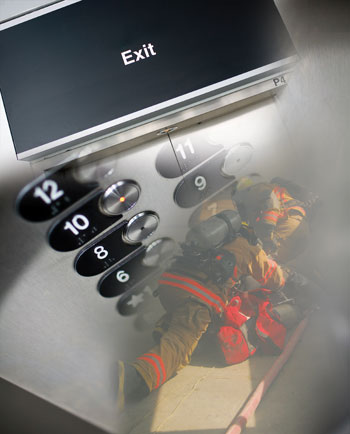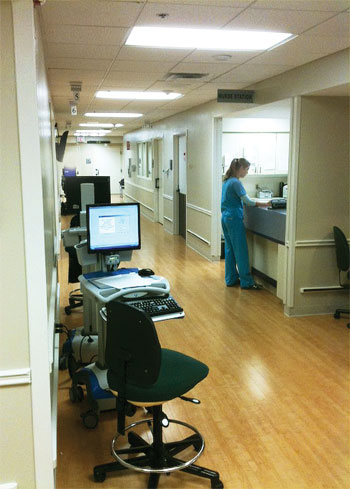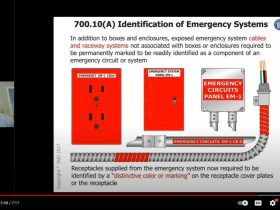 Selective coordination of the emergency system is intended to provide a high level of reliability and continuance of supply needed for systems providing emergency functions. As with all electrical installations, an effective plan review and installation inspection of the overcurrent protective devices (OCPDs) coordination for emergency systems is fundamental in approving and inspecting such systems. In addition, understanding which circuits require emergency systems also must be considered. Chapter 27 in the International Building Code (IBC) establishes a number of occupancies and systems that require emergency power such as egress illumination, exit signs, and hazardous materials occupancies. Let’s start by looking at the foundational elements for selectivity found in the NEC.
Selective coordination of the emergency system is intended to provide a high level of reliability and continuance of supply needed for systems providing emergency functions. As with all electrical installations, an effective plan review and installation inspection of the overcurrent protective devices (OCPDs) coordination for emergency systems is fundamental in approving and inspecting such systems. In addition, understanding which circuits require emergency systems also must be considered. Chapter 27 in the International Building Code (IBC) establishes a number of occupancies and systems that require emergency power such as egress illumination, exit signs, and hazardous materials occupancies. Let’s start by looking at the foundational elements for selectivity found in the NEC.
The 2011 NEC defines selective coordination in Article 100 as…
Coordination (Selective). Localization of an overcurrent condition to restrict outages to the circuit or equipment affected, accomplished by the choice of overcurrent protective devices and their ratings or settings.
In layman’s terms, selective coordination means that only the overcurrent protective device nearest to a fault should clear the fault. This applies to all fault types: overload, ground fault, and short circuit.
For emergency systems, the requirements for selective coordination are provided in NEC 700.27.
700.27 Coordination. Emergency system(s) overcurrent devices shall be selectively coordinated with all supply side overcurrent protective devices.
The “mystery” of selective coordination compliance can be easily overcome with training. Where desired, current staff capabilities can be expanded with education and experience and several OCPD manufacturers have excellent programs to assist in this area. Although it is not necessary to understand the myriad of devices and equipment considered in a selective coordination analysis, enforcers intending to review coordination designs should understand the types of documents which should be supplied and how to interpret them.
How do I get started? From an enforcement perspective, there are two basic paths which can be taken. A community that has a plan review department often has the expertise to understand and review the coordination documents while smaller communities without plan review may have a policy which relies solely on the designer or professional engineer to provide the appropriate documentation for field inspection of settings.
Performance Level
It is important to remember that the NEC requirements apply to the installation; however, the performance requirements come from other documents. In addition to specifying which systems must have emergency power, Chapter 27 of the 2012 International Building Code requires compliance with NFPA 110 in Section 2702.1.
IBC 2702.1 Installation. Emergency and standby power systems required by this code or the International Fire Code shall be installed in accordance with this code, NFPA 110 and 111.

Health Care facilities establishes the minimum performance requirements for Healthcare Systems. Photo courtesy of John Watson
NFPA 110-2010, Standard for Emergency and Standby Power Systems, sets the minimum performance requirements for Emergency Systems and NEC Article 700 specifies the material and process associated with putting equipment in place and making it ready for use in accordance with the specified performance requirements. NFPA 110 Section 6.5.1 requires OCPDs be coordinated to optimize selective tripping and A.6.5.1 recognizes there are certain systems which require practical limits or levels.
NFPA 110, 6.5.1 General. The overcurrent protective devices in the EPSS shall be coordinated to optimize selective tripping of the circuit overcurrent protective devices when a short circuit occurs.
NFPA 110, Annex A, A.6.5.1. It is important that the various overcurrent devices be coordinated, as far as practicable, to isolate faulted circuits and to protect against cascading operation on short circuit faults. In many systems, however, full coordination is not practicable without using equipment that could be prohibitively costly or undesirable for other reasons. Primary consideration also should be given to prevent overloading of equipment by limiting the possibilities of large current inrushes due to instantaneous reestablishment of connections to heavy loads.
NFPA 99-2012, Health Care Facilities Code, establishes the minimum performance requirements for Healthcare Systems and NEC Article 517 specifies the material and process associated with putting equipment in place and making it ready for use in accordance with the specified performance requirements. NFPA 99 clauses 6.4.2.1.2, 6.5.2.1.1 and 6.6.2.1.1 set the performance requirements for Types 1, 2, and 3 essential electrical systems with additional explanation provided in Annex A clauses A.6.4.2.1.2, A.6.5.2.1.1 and A.6.6.2.1.1.
NFPA 99, 6.4.2.1.2Selective Coordination. Overcurrent protective devices serving the essential electrical system shall selectively coordinate for the period of time that a fault’s duration extends beyond 0.1 second.
NFPA 99, Annex A, A.6.4.212. It is important that the various overcurrent devices be coordinated, as far as practicable, to isolate faulted circuits and to protect against cascading operation on short-circuit faults. In many systems, however, full coordination could compromise safety and system reliability. Primary consideration also should be given to prevent overloading of equipment by limiting the possibilities of large current inrushes due to instantaneous reestablishment of connections to heavy loads.
While these performance requirements provide the minimum acceptable level, many system designers and engineers will design to obtain higher levels. It is also important to note that some jurisdictions across the country have set specific requirements for the qualifications of selective coordination design personnel and set performance levels which must be followed.
Installation Inspection
Reviewing the coordination documents is just the beginning, ensuring that the installation matches the coordinated design can be an equally challenging hurdle once the equipment has been installed. Manufacturers typically ship equipment with the circuit breaker settings at minimum levels and fusible disconnects without fuses installed. Depending upon the system design, there may be other adjustable devices such as ground-fault relays, circuit protection relays, zone-selective interlocking and energy-reducing maintenance systems with required settings and adjustments. Proper device verification for each circuit breaker or fuse and the settings for any adjustable devices are essential to the performance of the system. A systematic approach using the emergency system one line diagram and the selective coordination documentation is required to perform the system inspection including device type, and settings.
Maintaining Coordination
Since the selective coordination is device and settings dependent, how long will the system be coordinated after inspection? Replacement of fuses or circuit breakers with different types or from a different manufacturer has an impact on the selective coordination of the system. It is important that the maintenance staff understand these constraints and communicate this to their staff. In some cases, marking should be added to provide this communication at the device to ensure that quick response actions don’t impact the coordination by installation of the wrong fuse or breaker.
Summary
Key installation items to verify:
Compliance begins with understanding where emergency power is required. The IBC, Chapter 27, specifies systems and occupancies which must have emergency power.
Determination of the required performance level utilizing NFPA 110, NFPA 99 and any local jurisdictional rules.
A selective coordination study and resulting documents providing device details. Simply walking through and looking at the system devices will not verify the coordination unless a study has been completed.
Ensure adjustable trip settings for the system devices are appropriately set.
When using ratio tables for fuses or selectivity table for circuit breakers, confirm all of the fuses and breakers in the system are the appropriate size, type and from the same manufacturer.
Check the ground fault and other protection relay adjustments and settings.
Consider recommending markings to communicate proper adjustment of breaker settings, and replacement of fuses with specific manufacturer brand and type.
Selective coordination of emergency systems may seem like a difficult task but like many worthwhile challenges the most difficult step is getting started. The life safety importance of emergency systems warrant the performance and installation requirements provided in NFPA 99, NFPA 110 and NEC Article 700. Understanding the codes and standards requirements along with any jurisdictional regulations form the foundation for plan review and installation inspection of these systems. The key implementation items provide areas to verify and potential maintenance concerns to consider as the system is inspected.
Read more by Chad Kennedy










Find Us on Socials